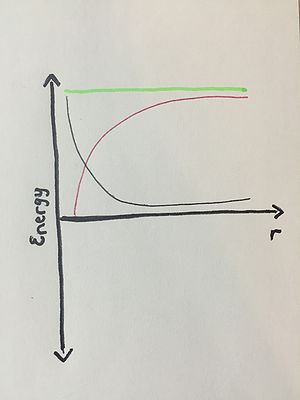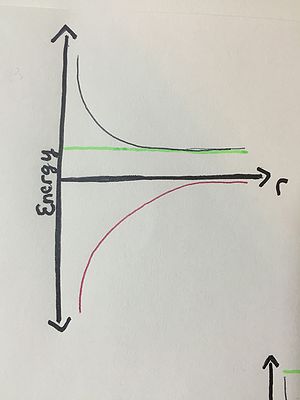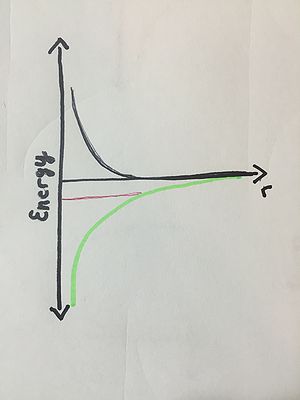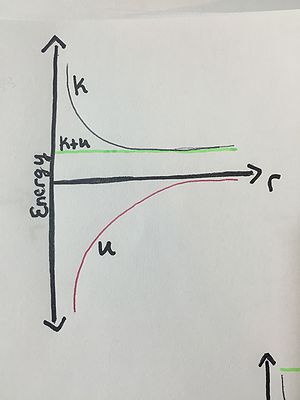Energy Graphs: Difference between revisions
| Line 48: | Line 48: | ||
===A Computational Model=== | ===A Computational Model=== | ||
Vpython is great for modeling | Vpython is great for modeling energy graphs. Using Vpython, we can model many different systems that have kinetic and potential energies. For example, we can model a spacecraft orbiting the Earth, and we can create graphs to display the kinetic, potential, and kinetic+potential energies of this system. See this code for how to model these interactions using Vpython! This specific code shows the spacecraft + Earth system. | ||
[Sample Vpython code:https://trinket.io/glowscript/4010e21bc3] | [Sample Vpython code:https://trinket.io/glowscript/4010e21bc3] | ||
Revision as of 22:48, 1 December 2015
Claimed by Julianne Oliver
What is an Energy Graph?

Energy graphs are extremely useful for analyzing the interactions between two different objects. These graphs can also be confusing if not properly understood. How do all of the different pieces of an energy graph fit together? This page serves as a resource on how to construct and interpret energy graphs. Let's get started!
The Basics
Energy graphs are very useful for understanding different repulsive and attractive situations. These graphs consist of three main components: kinetic energy, potential energy, and kinetic plus potential energy. These three energies are plotted as a function of energy versus separation between two objects.
Let's review:
Kinetic Energy: the energy that a moving object has in addition to its Rest Mass Energy. Kinetic energy is K on an energy graph.
Potential Energy: the energy associated with multi-particle systems. This is the energy between interacting objects, and this energy can be either attractive or repulsive. Potential energy is U on an energy graph.
What is the sum? Simply the sum of the potential and kinetic energies displayed on the graph. We will discuss how to plot this value momentarily. K+U symbolizes the sum of the potential and kinetic energies.
Positive or Negative?
Kinetic energy can NEVER be negative! Potential energy is negative if the interaction is attractive and positive if the interaction is repulsive. The sum of the potential and kinetic energies depends on a few factors. If an object can "escape" from an attractive interaction, and, after having escaped, comes to rest, then K+U is equal to zero. If, however, the object escapes with some final velocity, then K+U is greater than zero. Lastly, in a bound state, an object cannot escape the interaction it is involved in, and K+U is negative.
More Important Tidbits
K (kinetic energy) is zero or nonzero depending on the motion of the objects. At rest, kinetic energy is zero. In motion, kinetic energy is greater than zero. In an attractive interaction, such as Gravitational Potential Energy, U (potential energy) increases (becomes less negative) and K decreases as two objects move farther away from one another. In a repulsive interaction, U(potential energy) decreases and K (kinetic energy) increases as the two objects move farther away from one another.
The x-axis of an energy graph is separation, denoted r, and the y-axis is energy.
How to Construct an Energy Graph
Now that you know the basics, practice constructing and analyzing energy graphs is the best way to fully grasp this concept. Here are some helpful steps for how to draw an energy graph:
1. Draw U first, based upon whether or not the interaction is attractive or repulsive. See the examples below in order to visualize how U looks when an interaction is attractive versus repulsive.
2. Choose an r where you know K, and at this point, plot the point (r, K).
3. Add the K value from step 2 to the U value at that same r value.
4. Plot K+U at this r value that you know both K and U.
5. Draw a horizontal line through this K+U point.
6. Find a K value at a different r value that, when added to U, gives K+U (the horizontal line you just drew).
7. With these two points on the K graph, sketch K vs. r.
A Computational Model
Vpython is great for modeling energy graphs. Using Vpython, we can model many different systems that have kinetic and potential energies. For example, we can model a spacecraft orbiting the Earth, and we can create graphs to display the kinetic, potential, and kinetic+potential energies of this system. See this code for how to model these interactions using Vpython! This specific code shows the spacecraft + Earth system.
[Sample Vpython code:https://trinket.io/glowscript/4010e21bc3]
Examples
See end for solutions to all examples.
Beginner
Label K, U, and K+U on the energy diagrams for the following situations:
Example 1: Two electrons are held at rest some finite distance apart, and they move away from each other after they are released. Their initial velocities are zero.

Example 2:
A proton and an electron start out far apart. Their initial velocities are nonzero, and their energy is repulsive.

Example 3:
A daughter has just enough energy to escape from her controlling mother (they have an attractive relationship).

Intermediate
Label K, U, and K+U on the following energy diagrams. THEN, label the following three energy graphs 1, 2, or 3 based on the following scenarios:
1: One of the components of this energy diagram is incorrect.
2: A proton and a electron are at rest, and they start out infinitely far apart.
3: An astronaut orbits the moon.
Advanced
Create an energy graph for each of the following situations.
Situation 1: A spacecraft is orbiting a moon. The spacecraft is given an initial velocity that allows the spacecraft to leave the moon's orbit with a final velocity greater than zero.
Situation 2: A boy jumps onto a merry-go-round and is attracted to the merry-go-round's axle. The boy's initial velocity is not large enough for him to escape the merry-go-round, so he continues to "orbit" the merry-go-round.
Situation 3: Two people are repulsed by on another and are trying to fight. They are held at rest by two of their friends a finite distance apart, and they of course move away from one another as soon as they are released, since their friends will not let them approach one another.
Solutions to Beginner Examples
Example 1:
Example 2:
Example 3:
Solutions to Intermediate Examples
Example 1:
K+U is incorrect!
Example 2:
Example 3:
Solutions to Advanced Examples
Situation 1:
Situation 2:
Situation 3:
Energy and My Future
How is energy related to my future? How is energy related to the things I am passionate about? How is energy and physics related to biochemistry, medical school, and surgery? In order to get into medical school, I must first take the MCATs. Physics and math majors score the highest on the MCATs, so physics is extremely important to master in order to successfully master the MCATs. Energy is everywhere, so I need to understand energy in order to be successful in the future. Physics is a part of everyday life. Energy is a part of everyday life. Mastering both now will only aid me in my dream of becoming a surgeon. From medical school student, to intern, to surgical resident, to, one day, a surgeon, energy and physics will follow me. Energy graphs only help to explain different energy interactions and make understanding energy simpler. Energy is a part of every scalpel I will hold, and kinetic energy will push me through the late nights and long shifts in my future. Is energy applicable to my future? Is energy applicable to medicine and surgery? Absolutely! Physics is more applicable to every aspect of my life than I ever could have imagined.


History
Gustave-Gaspard Coriolis first described "kinetic energy" in 1829, and William Rankine coined the term "potential energy" in 1853.
Energy was proven mathematically in 1918.
Emmy Noether (1882-1935) uncovered the fundamental justification for conservation laws.
Why is the discovery of energy so important? Energy and the conservation of energy drive our everyday lives. Everything we touch, eat, drink, and use has energy! Without energy, there would be no life as we know it. The laptop you are using right now? Potential energy. Your hand scrolling through this page? Kinetic energy. Everything has energy! And these energy graphs are a great way to help us learn how to interpret energy in different situations.
Further reading
Matter and Interactions by Ruth W. Chabay and Bruce A. Sherwood
External links
Gravitational Potential Energy
References
Chabay, R. W. & Sherwood, B. A. (2015). Matter and interactions. North Carolina State University: John Wiley & Sons, Inc.
Physics 2211 Test 3
https://en.wikipedia.org/wiki/History_of_energy
Physics 2211 lecture notes








